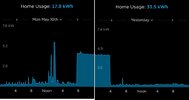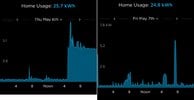Before I try submitting a service request to Tesla, which I’m predicting will go nowhere, does anyone know if there is a timezone setting somewhere that controls how home usage data is logged in the app?
I typically charge my EVs overnight and am seeing that some of the nightly home usage data is being logged for the next day. From my calculations, it seems that home usage as of around 9pm my time (Pacific) forward is being counted for the next day, which makes me think that my account is on Eastern somehow but I can’t find anything in my account or settings that shows a timezone.
I’ve attached example graphs. My actual home usage on 5/10 was more than 5/11, but 5/11 is being counted as a lot more. And 5/6 & 7 is being counted as almost the same when 5/6 is clearly a lot more usage based on the graph. I’m seeing this same behavior consistently on other days.
Not a big issue in the bigger picture but any ideas on anything I can do before I contact Tesla?
I typically charge my EVs overnight and am seeing that some of the nightly home usage data is being logged for the next day. From my calculations, it seems that home usage as of around 9pm my time (Pacific) forward is being counted for the next day, which makes me think that my account is on Eastern somehow but I can’t find anything in my account or settings that shows a timezone.
I’ve attached example graphs. My actual home usage on 5/10 was more than 5/11, but 5/11 is being counted as a lot more. And 5/6 & 7 is being counted as almost the same when 5/6 is clearly a lot more usage based on the graph. I’m seeing this same behavior consistently on other days.
Not a big issue in the bigger picture but any ideas on anything I can do before I contact Tesla?




